Welcome to our website darasahuru.co.tz, in this article, Are you looking for Physics Form One Topic 7: Pressure - Physics Notes, Form One Physics notes.
PRESSURE
Pressure is defined as the compressive force acting normally per unit area;

The SI units of pressure is Newton per metre square (N/m2)
Other units of pressure are Pascal (Pa), Atmosphere (atm), Millimeter of mercury (mmHg) and Torre bar (bar).
NB.
1Pa = 1N/m2 1atm = 760mmHg
1atm = 100000N/m2 1atm = 1bar
Pressure due to Solid
Pressure on solid depends on force applied and the surface area.
That is 𝑷𝒓𝒆𝒔𝒔𝒖𝒓𝒆(𝑷)

Example.
4. Find the pressure exerted when a force of 640N acts in the area of 16m2
Solution:

Force (f) = 640N Area (A) =16m2 Pressure (p) =?
Assignment
1. A pressure of 75N/m2 is resulted from a certain force acting on an area of 0.8m2. Calculate its force acting on it. (ANS: F= 60N)
2. Find the pressure exerted when a force of 3600N act on the area of 36m2
Maximum and Minimum Pressure
Maximum pressure is the value of high pressure and it is determined when a force acts perpendicular to the smallest area.

Minimum Pressure is the value of low pressure obtained when a force acts normally per largest area

N.B
Pressure depends upon the area (The smaller the surface area the greater the pressure and vice versa)
For example it is easy to cut the meat using a sharp knife than a blunt one, this is because the sharp knife has smaller area which produces the larger pressure than the blunt one.
Examples
1. A rectangular block weighting 320 N has dimensions 4 m by 2 m by 10 m. what is the greater pressure and the least (minimum) pressure it can be exerted on the ground
SOLN
Maximum area = 4 x 10 = 40 m2
Minimum area = 2 x 4 = 8 m2

Assignment
1. A woman weighting 500N wear a pair of shoes with heels of area 250 m2, what is the pressure exerted on the floor by a heel of her shoes? (ANS: P = 2 N/m2 )
2. Calculate the pressure under the feet of Fatima if the area of contact of her foot is 80 cm2 and her mass is 43.8 kg
3. The tip of the needle with cross section area of 0.000001m2, if a doctor applied a force of 20N to a syringe that is connected to the needle. Find the pressure exerted at the tip of the needle ANS: P = 20000000 N/m2
4. A rectangular metal block with sides 1.5 m by 1.2 m by 1.0 m rests on a horizontal surface .If the density of the metal is 7000 kg/m3, calculate the
maximum and minimum pressure that the block can exert on the surface. (Take the weight of 1 kg mass to be 10 N)
5. The mass of cuboid is 60 kg. If it measures 50 cm by 30 cm by 20 cm. What is the maximum pressure that it can exert?
6. A rectangular block of weight 15 N rests on a horizontal table. If it measures 40 cm by 30 cm by 20 cm, calculate the greatest and least pressure
Examples of Solid Pressure in daily life
We experience pain discomfort when we lift a bucket of water made by thin handle
Sharp edges of knife or razor cuts easily than blunt knife or razor
Sharp pointer of nail, screw, push pin, spear and an arrow has high penetrating power
Wide wooden or concrete (large area) sleepers are placed below the railway track to prevent railway track to penetrate on ground.
Buildings are constructed with wide (large area) foundation to increase surface area so as to prevent wall from penetrating on ground
Feet of elephant cannot sink into soft soil even if it is very heavy due to large surface area over elephant feet
A tractor works on soft ground cannot sink due to wide tyres
Duck cannot sink on soft mud due to large surface area on his webbed feet
Potter puts some soft material on his/her head for heavy load to increase surface area
It is painfully to walk on barefoot on a road that is covered by pebbles
Pressure in Liquids
A liquid will exert pressure on an immersed object as well as on the walls of the container holding it
The pressure in the liquid increases with the increase in depth of the liquid
Pressure in a liquid act equally in all directions
Pressure in a liquid increase with the increase in density of the liquid
From pressure:

The pressure in liquids is given by

The pressure at any point in a liquid at rest depends on:
a) Depth (height through which the liquid rises)
b) Density of the liquid
Variation of pressure with depth
The pressure in a liquid increases with depth (the greater the height above a point , the greater the pressure at that point)
This can be demonstrated by the following experiment
a) Take a tall vessel and make three holes of the same diameter from the top downward

Observations:
Water is pushed through the holes at different speeds. More water is pushed through hole A than hole B, and least water is pushed through hole C
The pressure at hole A is greater than that at hole C due to different in heights (ie. Pressure in a liquid increase with depth)
That is why the bottom of a dam is made thicker than the top because the pressure at the bottom is much greater than at the top
Question
1. Explain why a diver at the bottom of the dam experiences greatest pressure ANS: At the bottom of the dam the depth is greatest and therefore the diver experiences greatest pressure due to the weight above him
Examples of Pressure in liquid in real life
The water bubbles increase in its volume if moves from the bottom of the pond to the top of the pond (depth decreases)
Water tanks have their outlets fixed at the bottom (high depth)
A person at great height suffers from nose bleeding
A hole at the bottom of a ship is more dangerous than one near the surface
A dam is thicker at the bottom than at the top
Communicating Vessel
Communicating vessel finds its own level even though each part has different shape, the liquid will be at the same level in all parts
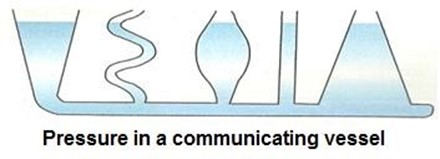
Spirit Level
Is an instrument used to test whether a surface is horizontal or vertical.
It consists of a slightly curved glass tube which is not completely filled with a liquid (yellow in color) leaving a bubble in the tube

Mechanism
A spirit level works on the fact that a liquid in a vessel will always find its own level.
A Spirit level is used by
- Masons
- Carpenters
- Surveyors e.t.c
Examples
1. What will be the pressure due to column of water of height 4m?
Data given
Solution
Height, h = 4m
Density of water, ρ = 1000kg/ m3 = 1g/cm3 Gravitation force, g = 10N/kg
Pressure exerted, P =?
From: P = ρhg
Consider the diagram below
2. A cube of sides 2cm is completely submerged in water so that the bottom of the cube is at depth of 10cm. Find
a) Different pressure between top and bottom of the cube
b) Different force between top and bottom of the cube
c) Weight of water displaced by the cube
Solution
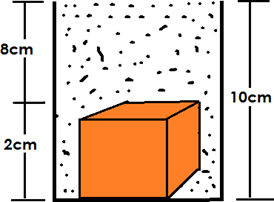
a) Different pressure between the top and bottom of the cube, ΔP =?
Data given
Water density, ρ = 1000kg/ m3 = 1g/cm3
Gravitation force, g = 10N/kg
Height at top, h2 = 8cm = 0.08m
Height at top, h1 = 8cm = 0.1m
Solution
Water density, ρ = 1000kg/ m3 = 1g/cm3 Gravitation force, g = 10N/kg
Height at top, h2 = 8cm = 0.08m Height at top, h1 = 8cm = 0.1m
a) Different force between top and bottom of the cube, ΔF =?
From:

But: A = 2cm x 2cm = 4cm2 = 0.0004 m2
b) Weight of water displaced, w =?
The volume of water displaced = Volume of the cube
Then: volume of water (cube) = (2 x 2 x 2) cm3 = 8cm3
Mass of water displaced = volume x density = 8 cm3 x 1 g/cm3 = 8 g
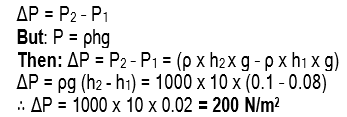
c) Weight of water displaced, w =?
The volume of water displaced = Volume of the cube
Then: volume of water (cube) = (2 x 2 x 2) cm3 = 8cm3
Mass of water displaced = volume x density = 8 cm3 x 1 g/cm3 = 8 g

Assignment
Where necessary use g = 10 N/kg, density of water = 1000 kg/m3 (1g/cm3)
1. The pressure at a bottom of a well is 98000 N/m2. How deep is the well
2. Calculate the pressure exerted on a diver at a depth of 20m below the surface of water in a sea (ANS: P = 200000 Pa)
3. A rectangular tank measures 5 m by 3 m at its base .It contains water to a height of 3m. Calculate the pressure on the base of the tank .
4. A small submarine has an area of 1 000 m2. What force would be exerted on the submarine by the water if it was submerged to a depth of 50 m?
5. Given that there is a considerable decrease in atmospheric pressure of 1.2 x 103 Pa for every 100 m increase in height ,determine the density of air
Pascal's Principle of the hydraulic Press
It states that: "Any external pressure applied to the surface of an enclosed liquid will be transmitted equally throughout the liquid"
OR
"Pressure applied at a point in a fluid at rest is transmitted equally to all parts of the fluid"
Consider the diagram below
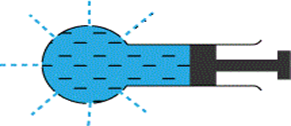
Hydraulic Press
Is a machine press using a hydraulic cylinder to generate a compressive force
Hydraulic press uses Pascal's principle to multiply an applied effort using the pressure of a liquid or gas. This allows the lifting of a heavy load by applying little effort
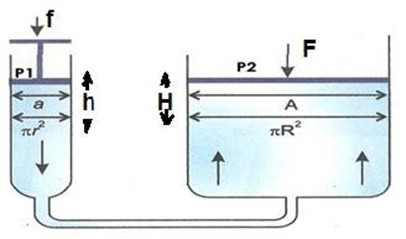
According to Pascal's principle, pressure will be transmitted equally through the fluid(oil) (P1 = P2)

Also, From: The principle of moment
Anticlockwise moment = clockwise moment

Example
1. In a hydraulic press the area of the piston to which the effort is applied is 5 cm2. If the press can raise a weight of 2 KN when an effort of 400N is applied, what is the area of the piston under the load?
Solution:
Given: Small Piston Force, f =400 N
Large Piston Force, F = 2 KN = 2000 N Small piston area, a = 5 cm2
Large piston area, A =?

∴ The area of the piston A = 25 cm2
Assignment
1. Hydraulic press has a large circular piston of diameter 0.7 m and circular piston to which the effort is applied of diameter 0.21 m. A force of 300N is exerted on the small piston. Find the force required to lift a heavy load (ANS: F = 3333.33N)
2. Pistons of hydraulic press have their areas given as 0.0003 m2 and 0.02 m2 respectively. A120 N is required to push down the small piston, find the force required to push the large piston (ANS: F = 8000 N)
3. A hydraulic lift has piston with areas of 0.02 m2 and 0.1m2. A car with a weight of 5000 N sits on a platform mounted on the large piston
a) How much force applied on small piston (ANS: F = 1000 N, h = 1.5 m)
b) How for must small piston fall when large piston raise the car at 0.3m?
3. A car of mass 8000kg, one of its tyres having an area of 50 cm2 in contact with ground. Find the pressure of the four-wheel car exerted on the ground by the car (ANS: P = 4000000 N/m2)
Uses of Hydraulic Press in Daily Life
1. Used in lifting heavy loads to the required height
2. In ginneries to compress a lump of cotton into small bales
3. In industries to form car bodies into the required shapes
4. Extraction of oil from the oil seed
5. Cranes used during construction of any project
6. Office chairs use hydraulic systems to lift or lower or lean back the seats
7. Brakes of cars use hydraulic systems
8. Hydraulic jack for lifting car up for any repair
Hydraulic brake system
When force is applied on the brake pedal, it exerts pressure on the master cylinder
Then this pressure is transmitted by the brake fluid to the slave cylinders which cause the pistons of the slave cylinders to open the brake shoe and hence the brake lining presses the drum.
The rotation of the wheel is then resisted and when the force on the brake pedal is withdrawn the return spring pulls back the brake shoe which then pushes the slave cylinders piston back
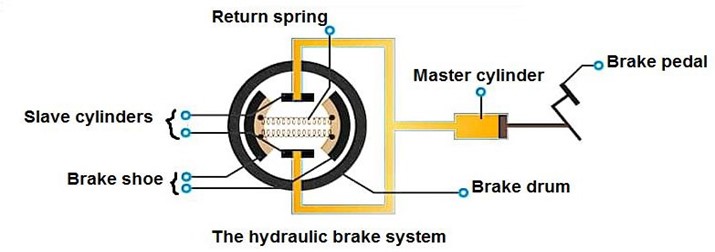
Manometer
Is a device used for measuring fluid (gas) pressure
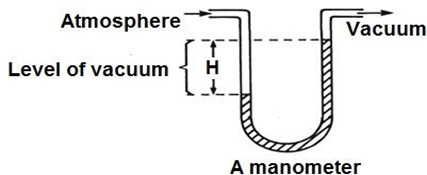
It is a u-shaped glass tube, open at both ends and holding liquid (water/mercury)
Mechanism of Manometer
One limb is connected to the fluid supply and the other limb is opened to the atmosphere. The pressure exerted on a fluid causes the level of water or mercury on manometer to rise at a certain height as shown in the figure above.
The difference in level (h) of the liquid in the two limbs records the pressure and the height h is called "the liquid head"
Liquids Densities
Hare's apparatus is used to compare the densities of two liquids
When the air at the top as shown in the fig. below is sucked out, the atmospheric pressure pushes the liquid up the tubes (This is because the atmospheric pressure acting on the surface is now greater than the pressure inside the straw)
On closing the openings when the liquids have reached a convenient height for measurement, the liquids produce the same pressure at X and Y

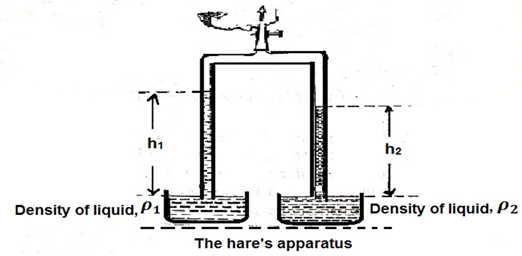
Atmospheric Pressure
Is the pressure within the atmosphere of the earth OR
N.B:
Is the pressure exerted by the weight of the atmosphere
Atmospheric Pressure decreases with the increase in altitude
At high altitudes, where the pressure of the air is less , nose – bleeding may occur due to the greater excess pressure of the blood which causes blood capillaries to burst
How Gas exerts Pressure?
Gas exerts pressure when its molecules are continually colliding with each other and with the walls of the container causing a small force on the wall. The pressure exerted by the gas is due to the sum of all these collision forces. The more particles that hit the walls, the higher the PRESSURE
Atmospheric pressure can be observed in several areas.
Example: -
- In a glass tumbler
- In a crashing can
Experiments to demonstrate effects of Atmospheric Pressure
a) In a glass tumbler
b) In a crashing can
In a glass tumbler
Fill the glass tumbler with water and place the card firmly on top of the glass so that there is no air between the glass and the glass
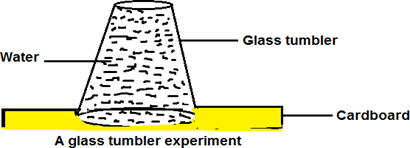
With your hand on the card, gently turn the tumbler upside down , then remove your hand
Observations
The card holds on the tumbler when it is turned upside down. This is because the atmospheric pressure acting upwards on the card is greater than downward pressure of water acting on the card
In a crashing can
Put a little water in a can. Boil the water while the can is open in order to drive off the air (fig.(a))
Remove the heating source and quickly close the hole tightly
Poor cold water over the can
Observations

Barometer
Is an instrument used to measure atmospheric pressure
Simple Barometer
This is the most fundamental of the other types of barometer.
It uses mercury instead of water because mercury is denser than water
It has a height of 76 cm at sea level. Therefore, the atmospheric pressure at sea level is 76 cm of mercury (76 cmHg)

Atmospheric pressure is given by: P = ρ h g Fortin Barometer
Fortin Barometer is a modified simple barometer. It is a very accurate type of mercury barometer for measuring air (atmospheric) pressure.
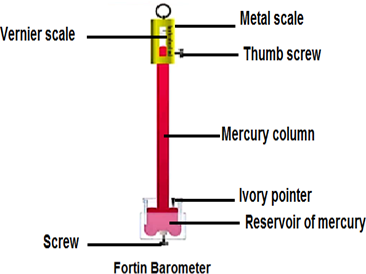
Aneroid Barometer
Is a barometer which is mostly used in aeroplanes to record the air pressure at a certain altitude
Aneroid Barometer does not use any liquid. It consists of an evacuated metal box connecting a system of levers and a pointer. It is compacted and portable
Aneroid barometer which is used in aircraft to show the height at which the plane is flying is called Altimeter
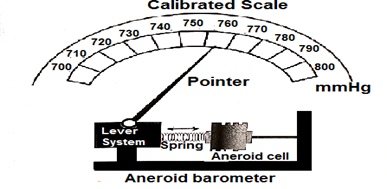
Aneroid Barometer
It is used to measure air pressure in confined spaces
It is compact and portable
It is used in aircraft to show the height at which the plane is flying (The barometers used are called Altimeters)
Disadvantages of using Fortin barometer
a) Mercury is expensive and toxic
b) It is not portable (it is approximately 1 m tall and contains liquid)
c) It must be mounted in a vertical position
NB:
Aneroid barometer which is used in aircraft to show the height at which the plane is flying is called Altimeter
Application of Atmospheric Pressure
There are a variety of common and even simple devices that work under atmospheric pressure (working under the Principle that air exerts pressure).
These include
1. Siphon
2. Lift pump
3. Force pump
4. Syringe
5. Bicycle pump
Siphon
Is a tube or pipe that allows liquid to flow from the higher level to the lower level
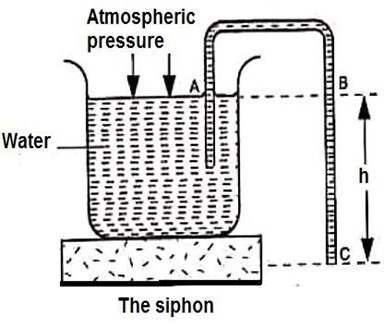
The pressure on the surface of the liquid is atmospheric pressure.
Since end C of the tube is below the surface A by height h, thus the pressure at C is greater than that at the surface. (ie. Pressure at C = pa + 𝝆𝒉𝒈)
NB: Siphon can lift water about 10 m below the ground
Application of Siphon in everyday life
It is used in the toilet flushing cisterns (Chain and ball flushing tank)
It is used in Siphon rain gauge to automatically drain out the excess water
A siphon cup is a reservoir attached to a gun
It is used in some drainage systems to drain water to another point
Lift Pump
Is used to raise water from underground water sources.
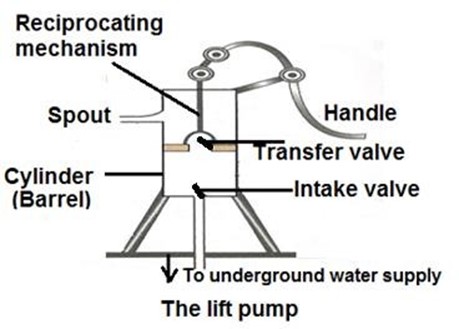
How it works
The pump starts with the piston at the bottom of the empty cylinder and both valves closed (fig.(a))
The pump handle is then pushed down lifting the piston upwards (upstrokes). The transfer valve remains closed and the intake valv opens to allow water from the external source to fill the lower chamber(fig.(b)). This is due to the low-pressure region created between the valve A and the Piston
The handle is then lifted upwards pushing the piston down (Down strokes). The intake valve now closes and the transfer valve opens (fig.(c)). This allows water to pass into the upper chamber
Finally, the pump handle is pushed down again lifting the piston upward. Transfer valve closes and Intake valve opens to allow water from the external source to fill the lower chamber. The water in the upper chamber is lifted and flows out of the spout (This process is repeated continuously)
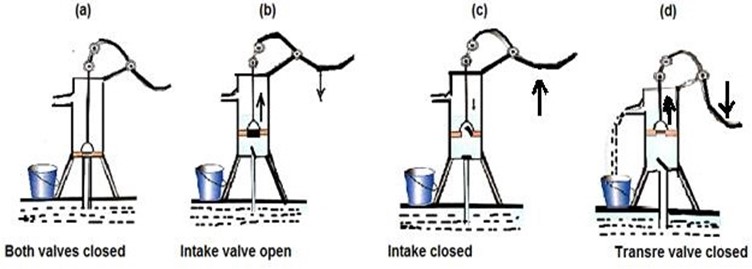
Limitation of Lift Pump
It can lift water up to height of 10 m
Few strokes are required
Force Pump
Is a modified of a lift pump which can be used to raise water to a height of more than 10 m
Advantages of a force pump over a lift pump
Force pump enables continuous flow of water
Force pump is able to move water from greater depths than the lift pump
Height to which water can be raised does not depend on the atmospheric pressure
Syringe
Is a simple piston pump that is used to inject fluid into or withdraw fluid from the body

How it works
It consists of a plunger that fits in a tube. The plunger is pulled and pushed while inside a cylindrical tube or barrel. This action enables the syringe to take in or expel fluid through the opening (nozzle) at the end of the tube
Uses of the Syringe
Used for medical purpose e.g. Injecting vaccines
They are used to measure liquids and gases in the laboratory
Used to apply in a certain compound such as glue or lubricant
Bicycle Pump
Is a type of force pump that consists of a hollow metal cylinder and a movable piston
It is specifically designed for inflating bicycle tyres

Mechanism
When piston is pulled out, a low pressure is created in the region just below the piston. The atmospheric pressure then forces air into the pump trough the space between the piston and the metal cylinder
And when the piston is pushed in, the trapped air below the piston is compressed and the tube of the bicycle is then inflated using a valve
N.B:
Other examples (applications) of atmospheric pressure in our daily life are:-
Detecting altitude of hills and mountains
Drop ink through ink dropper
Drinking straws
Inflate vehicle tires
Cleaning house using vacuum cleaners
Enhance passage of air for breathing etc.
Basic Assignment
Use acceleration due to gravity, g = 10 m/s2 Atmospheric pressure = 101 325 N/m2
1. Define the term pressure and state its SI units
2. State two factors on which the pressure exerted by a fluid depends.
3. Calculate the pressure at the bottom of the pond 10 m deep if the density of water is 1000 kg/m3
4. With the application of the same force, a sharp knife cuts more easily than a blunt knife. Explain why?
5. A glass slab of density 2500 kg/m3 measures 20 cm x 10 cm x 50 cm. What is
a) Maximum pressure
b) Minimum pressure it exerts on a flat horizontal surface?
6. Why can't water be used as a barometric liquid?
7. Explain why a diver at the bottom of the dam experiences greatest pressure
8. Briefly explain how a bicycle pump works
9. A 40 N block exerts 20 Pa of pressure on a table. What is the area of the block that is touching the table? (ANS: A = 2 m2)
10. Explain the principle of a lift – pump
11. Briefly explain how drinking by using a straw is achieved
13. The density of mercury is 13600 kg/m3. Determine the liquid pressure at a point 76 cm below mercury level (ANS: P = 103,360 N/m2)
14. Calculate the pressure due to water experienced by a diver working 15 m below the surface. Given that density of sea water is 1.03 g/cm3 (ANS:P =154500 Pa)
15. Explain the following
a) A hole at the bottom of a ship is more dangerous than one near the surface
b) The bottom of the dam is made thicker than the top?
16.A submarine has a surface area of approximately 82 000 m2. If it is travelling at a depth of 300 m in the ocean, what is the total force on the submarine's outer hull?
17.A rectangular tank which measures 5 m by 4 m contains water to a height of 10 m . Calculate
(i) Pressure on the base
(ii) Thrust on the base
(ANS: P = 100,000 Pa, Thrust (Force) = 2,000,000 N)
18. A red cube with sides of 3 m and a blue cube with sides of 2 m are on a table. They both weigh the same .Which cube exerts more pressure on the table?
Calculate the value of the maximum and minimum pressure
(ANS: PMax = 400 N/m2, Pmini = 133 N/m2)
20. Match the items in List A with the correct ones from list B. Items A can be used more than once
| List A | List B |
a) Atmospheric pressure b) Pressure c) Pascal principle d) Application of atmospheric pressure e) Razor blades and knife blades | i. Minimum force ii. Hydraulic press iii. N/m2 iv. Pascal v. Maximum force (vi)Manometer vi. High pressure vii. Low pressure viii. Aneroid barometer ix. Bicycle pump |
20.A can holds water with a constant depth of 0.5 m. The surface of the water is exposed to the atmosphere .What is the pressure on the bottom of the can?
21.A can holds water with a constant depth of 1 m. Hole A is punched in the can
0.2 m below the surface of the water and hole B is punched 0.8 m from the surface. From which hole will the water spurt the furthest? Explain your answer
22.What are the advantages of using Aneroid barometer over Fortin barometer 23.Pressure in liquids depends on ---------------------- and ------------------------
23. State the Pascal's principle
24. Calculate the area of a surface of an object which exerts a pressure of 0.2 N/m2 when a force acting on it is 2 N (ANS: A = 10 m2)
25. Mention any two devices which apply Pascal's Principle
26. Given that both liquid A and liquid B exert the same amount of pressure, what would be height of column of liquid A if density of liquid A is twice density of liquid B and height of column of liquid B is 10 cm? (ANS: h = 5 cm)
27. Water density, ρ = 1000kg/ m3 = 1g/cm3 Gravitation force, g = 10N/kg
28. Height at top, h2 = 8cm = 0.08m Height at top, h1 = 8cm = 0.1m

